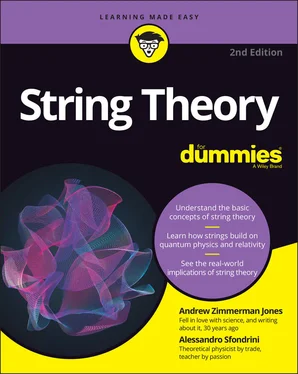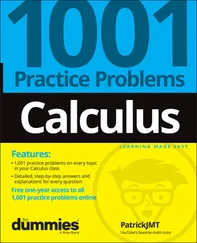If string theory were wrong, it would have collapsed in on itself well before now, instead of passing many mathematical consistency checks (such as those discussed in Chapter 10) and providing more and more elaborate ways to be interpreted, such as the dualities and symmetries that allowed for the presentation of M-theory (discussed in Chapter 11).
This is how theoretical physicists think, and it’s why so many of them continue to believe that string theory is the place to be. The mathematical beauty of the theory, the fact that it’s so adaptable, is seen as one of its virtues. The theory continues to be refined, and it hasn’t been shown to be incompatible with our universe. There has been no brick wall where the theory failed to provide something new and — in some eyes, at least — meaningful, so those studying string theory have had no reason to give up and look somewhere else. (The history of string theory in Chapters 10and 11offers a better appreciation of these achievements.)
Whether this resilience of string theory will translate someday into proof that the theory is fundamentally correct remains to be seen, but for the majority of those working on the problems, confidence is high.
As you can read in Chapter 18, this popularity is also seen by some critics as a flaw. Physics thrives on the rigorous debate of conflicting ideas, and some physicists are concerned that the driving support of string theory, to the exclusion of all other ideas, isn’t healthy for the field. For some of these critics, the mathematics of string theory has indeed already shown that the theory isn’t performing as expected (or, in their view, as needed to be a fundamental theory) and string theorists are in denial.
Considering String Theory’s Setbacks
Because string theory has made so few specific predictions, it’s hard to disprove it, but the theory has fallen short of some of the hype about how it will be a fundamental theory to explain all the physics in our universe, a “theory of everything.” This failure to meet that lofty goal seems to be the basis of many (if not most) of the attacks against it.
In Chapter 18, you find more detailed criticisms of string theory. Some of them cut to the very heart of whether string theory is even scientific or whether it’s being pursued in the correct way. For now, we leave those more abstract questions and focus on three issues that even most string theorists aren’t particularly happy about:
Because of supersymmetry, string theory requires a large number of particles beyond what scientists have ever observed.
This new theory of gravity was unable to predict the accelerated expansion of the universe that was detected by astronomers.
A vastly large number of mathematically feasible string theory vacua (solutions) currently exist, so it seems virtually impossible to figure out which could describe our universe.
The following sections cover these dilemmas in more detail.
The universe doesn’t have enough particles
For the mathematics of string theory to work, physicists have to assume a symmetry in nature called supersymmetry, which creates a correspondence between different types of particles. One problem with this is that instead of the 25 fundamental particles in the Standard Model, supersymmetry requires at least 36 fundamental particles (which means that nature allows 25 more particles that scientists have never seen!). In some ways, string theory does make things simpler — the fundamental objects are strings and branes or, as predicted by matrix theory, 0-dimensional branes called partons . These strings, branes, or possibly partons make up the particles that physicists have observed (or the ones they hope to observe). But that’s on a very fundamental level; from a practical standpoint, string theory doubles the number of particles allowed by nature from 25 to 50.
One of the biggest possible successes for string theory would be to experimentally detect these missing supersymmetric partner particles. Many theoretical physicists hoped that when the Large Hadron Collider particle accelerator at the European Organization for Nuclear Research in Switzerland went online, it would detect supersymmetric particles. This hasn’t happened — yet.
Even if it’s found, proof of supersymmetry doesn’t inherently prove string theory, so the debate would continue to rage on, but at least one major objection would be removed. Supersymmetry might well end up being true, whether or not string theory as a whole is shown to accurately describe nature.
Dark energy: The discovery string theory should have predicted
Astronomers found evidence in 1998 that the expansion of the universe was actually accelerating. This accelerated expansion is caused by the dark energy that you hear about so often in the news. Not only did string theory not predict the existence of dark energy, but its attempts to use science’s best theories to calculate the amount of dark energy come up with a number that’s vastly larger than the one observed by astronomers. The theory just absolutely failed to initially make sense of dark energy.
Claiming this as a flaw of string theory is a bit more controversial than the other two problems, but there’s some (albeit questionable) logic behind it. The goal of string theory is nothing less than the complete rewriting of gravitational law, so it’s not unreasonable to think that string theory should’ve anticipated dark energy in some way.
When Einstein constructed his theory of general relativity, the mathematics indicated that space could be expanding (later proved to be true). When Paul Dirac formulated a quantum theory of the electron, the mathematics indicated an antiparticle existed (later proved to actually exist). A profound theory like string theory can be expected to illuminate new facts about our universe, not be blindsided by unanticipated discoveries.
Of course, no other theory anticipated an accelerating expansion of the universe either. Prior to the observational evidence, cosmologists (and string theorists) had no reason to assume that the expansion rate of space was increasing. Years after dark energy was discovered, it was shown that string theory could be modified to include it, which string theorists count as a success (although the critics continue to be unsatisfied).
Where did all these “fundamental” theories come from?
Unfortunately, as string theorists performed more research, they had a growing problem (pun intended). Instead of narrowing in on a single vacuum (solution) that could be used to explain the universe, it began to look like there were an absurdly large number of vacua. Some physicists’ hopes that a unique, fundamental version of string theory would fall out of the mathematics effectively dissolved.
In truth, such hype was rarely justified in the first place. In general relativity, for example, an infinite number of ways to solve the equations exist, and the goal is to find solutions that match our universe. The overly ambitious string theorists (the ones who expected a single vacuum to fall out of the sky) soon realized that they, too, would end up with a rich string theory landscape, as Leonard Susskind calls the range of possible vacua (see Chapter 12for more on Susskind’s landscape idea). The goal of string theory has since become to figure out which set of vacua applies to our universe.
STRING THEORY IS … INEVITABLE?
A modern take on the study of string theory turns the tables and asks, what else could be a good theory of quantum gravity? In this approach, physicists don’t try to construct new theories. Instead, they try to list all the properties that any reasonable theory of quantum gravity should have.
Читать дальше












